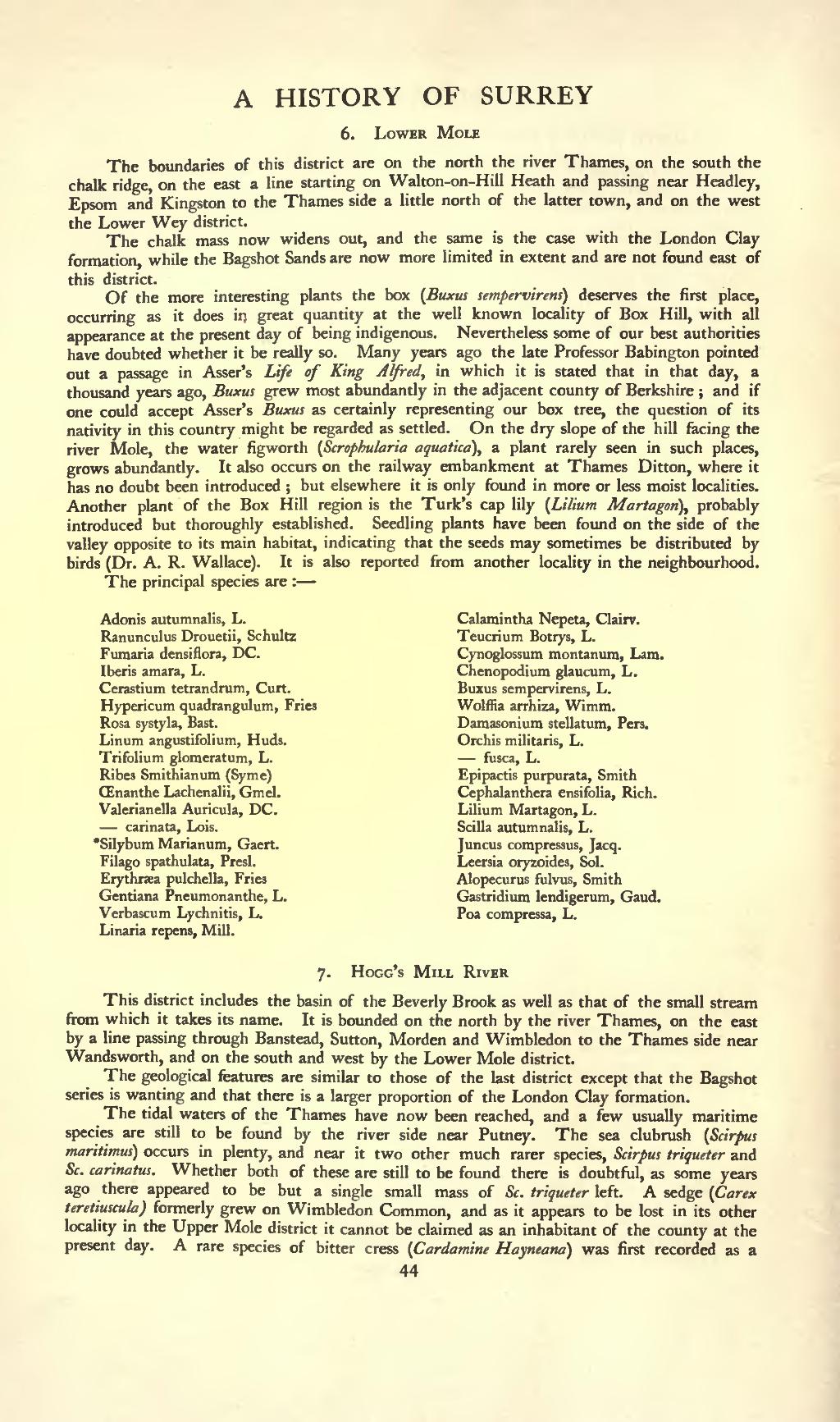A HISTORY OF SURREY 6. LOWER MOLE The boundaries of this district are on the north the river Thames, on the south the chalk ridge, on the east a line starting on Walton-on-Hill Heath and passing near Headley, Epsom and Kingston to the Thames side a little north of the latter town, and on the west the Lower Wey district. The chalk mass now widens out, and the same is the case with the London Clay formation, while the Bagshot Sands are now more limited in extent and are not found east of this district. Of the more interesting plants the box (Buxus sempervirens) deserves the first place, occurring as it does in great quantity at the well known locality of Box Hill, with all appearance at the present day of being indigenous. Nevertheless some of our best authorities have doubted whether it be really so. Many years ago the late Professor Babington pointed out a passage in Asser's Life of King Alfred, in which it is stated that in that day, a thousand years ago, Buxus grew most abundantly in the adjacent county of Berkshire ; and if one could accept Asser's Buxus as certainly representing our box tree, the question of its nativity in this country might be regarded as settled. On the dry slope of the hill facing the river Mole, the water figworth (Scrophularia aquatica), a plant rarely seen in such places, grows abundantly. It also occurs on the railway embankment at Thames Ditton, where it has no doubt been introduced ; but elsewhere it is only found in more or less moist localities. Another plant of the Box Hill region is the Turk's cap lily (Lilium Martagon), probably introduced but thoroughly established. Seedling plants have been found on the side of the valley opposite to its main habitat, indicating that the seeds may sometimes be distributed by birds (Dr. A. R. Wallace). It is also reported from another locality in the neighbourhood. The principal species are : Adonis autumnalis, L. Calamintha Nepeta, Clairv. Ranunculus Drouetii, Schultz Teucrium Botrys, L. Fumaria densiflora, DC. Cynoglossum montanum, Lam. Iberis amara, L. Chenopodium glaucum, L. Cerastium tetrandrum, Curt. Buxus sempervirens, L. Hypericum quadrangulum, Fries Wolffia arrhiza, Wimm. Rosa systyla, Bast. Damasonium stellatum, Pers. Linum angustifolium, Huds. Orchis militaris, L. Trifolium glomeratum, L. fusca, L. Ribes Smithianum (Syme) Epipactis purpurata, Smith CEnanthe Lachenalii, Gmel. Cephalanthera ensifolia, Rich. Valerianella Auricula, DC. Lilium Martagon, L. carinata, Lois. Scilla autumnalis, L.
- Silybum Marianum, Gaert. Juncus compressus, Jacq.
Filago spathulata, Presl. Leersia oryzoides, Sol. Erythrsea pulchella, Fries Alopecurus fulvus, Smith Gentiana Pneumonanthe, L. Gastridium lendigerum, Gaud. Verbascum Lychnitis, L. Poa compressa, L. Linaria repens, Mill. 7. HOGG'S MILL RIVER This district includes the basin of the Beverly Brook as well as that of the small stream from which it takes its name. It is bounded on the north by the river Thames, on the east by a line passing through Banstead, Sutton, Morden and Wimbledon to the Thames side near Wandsworth, and on the south and west by the Lower Mole district. The geological features are similar to those of the last district except that the Bagshot series is wanting and that there is a larger proportion of the London Clay formation. The tidal waters of the Thames have now been reached, and a few usually maritime species are still to be found by the river side near Putney. The sea clubrush (Scirpus maritimus) occurs in plenty, and near it two other much rarer species, Scirpus triqueter and Sc. carinatus. Whether both of these are still to be found there is doubtful, as some years ago there appeared to be but a single small mass of Sc. triqueter left. A sedge (Car ex teretiuscula) formerly grew on Wimbledon Common, and as it appears to be lost in its other locality in the Upper Mole district it cannot be claimed as an inhabitant of the county at the present day. A rare species of bitter cress (Cardamine Hayneana) was first recorded as a 44
